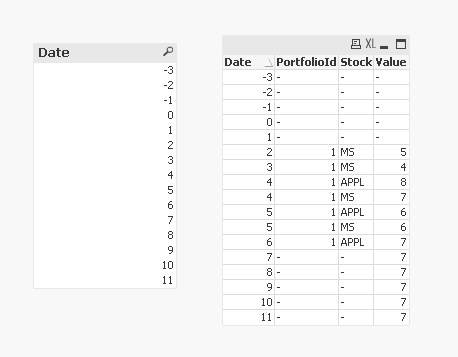Unlock a world of possibilities! Login now and discover the exclusive benefits awaiting you.
- Qlik Community
- :
- All Forums
- :
- QlikView App Dev
- :
- Calculate value based on no data
- Subscribe to RSS Feed
- Mark Topic as New
- Mark Topic as Read
- Float this Topic for Current User
- Bookmark
- Subscribe
- Mute
- Printer Friendly Page
- Mark as New
- Bookmark
- Subscribe
- Mute
- Subscribe to RSS Feed
- Permalink
- Report Inappropriate Content
Calculate value based on no data
Hello. I hope somebody could tell me how to do the following (and if it's possible using QlikView 11)
I need to create report for stock analysis and one of the calculated properties burns my mind.
There are entities named Portfolio. These portfolios contain a sets of positions (wich are stocks).
Each position starts some day from 1000$ and ends in another day with some value
For example:
Bob's portfolio
| Date | MS | APPL |
|---|---|---|
| 1 | ||
| 2 | 1000 | |
| 3 | 800 | |
| 4 | 1000 | 1500 |
| 5 | 1300 | 1400 |
| 6 | 1400 | |
| 7 | 1200 | |
| 8 | ||
| 9 | ||
| 10 |
Now I need to calculate a specific value for this whole portfolio for days 3-9. and here is how It should be calculated
(SUM(ALL_POSITIONS_END_DATE) / SUM(ALL_POSITIONS_START_DATE))
And here is the trick. My start date is 3 so MS should be 1000 and APPL 800 => SUM() = 1800
My end date is 9 so MS should be 1200 and APPL 1400 => SUM() = 2600
2600 / 1800 = 1,4444
But there are no data for MS days 3, 8, 9 and APPL days 6-9. I need to emulate it as I have the following dataset
Bob's portfolio
| Date | MS | APPL |
|---|---|---|
| 1 | ||
| 2 | ||
| 3 | 1000 | 800 |
| 4 | 1000 | 1500 |
| 5 | 1300 | 1400 |
| 6 | 1400 | 1400 |
| 7 | 1200 | 1400 |
| 8 | 1200 | 1400 |
| 9 | 1200 | 1400 |
| 10 |
- Mark as New
- Bookmark
- Subscribe
- Mute
- Subscribe to RSS Feed
- Permalink
- Report Inappropriate Content
If you can populate the fields in the load script you can follow this
http://community.qlik.com/blogs/qlikviewdesignblog/2013/02/05/populating-a-sparsely-populated-field
- Mark as New
- Bookmark
- Subscribe
- Mute
- Subscribe to RSS Feed
- Permalink
- Report Inappropriate Content
You could try creating a Master Calendar containing all dates from a suitable Start Date to a suitable End Date, and join that to your Fact table.
Then you'll have all the dates you require to report on, albeit some dates will have no rows in the Fact table but that can be accommodated.
Best Regards, Bill
- Mark as New
- Bookmark
- Subscribe
- Mute
- Subscribe to RSS Feed
- Permalink
- Report Inappropriate Content
Have you tried the FIRST() and LAST() functions on each column? They should pull the first and last value, respectively, for each field/column, within the selected date range.
- Mark as New
- Bookmark
- Subscribe
- Mute
- Subscribe to RSS Feed
- Permalink
- Report Inappropriate Content
Hello Greg
First() and Last() cannot be used inside aggregation functions such as Sum()
- Mark as New
- Bookmark
- Subscribe
- Mute
- Subscribe to RSS Feed
- Permalink
- Report Inappropriate Content
Hello Massimo.
That is a fantastic blog post but I'm afraid it will not solve my problem.
Here is a link to example QW file.
And here is a screenshot from it.

I need to make it work for each PortfolioId, Stock records separately.
2 1 MS 5
2 1 APPL 8
3 1 MS 4
3 1 APPL 8
4 1 MS 7
4 1 APPL 8
5 1 MS 6
5 1 APPL 6
......
- Mark as New
- Bookmark
- Subscribe
- Mute
- Subscribe to RSS Feed
- Permalink
- Report Inappropriate Content
Aleksander, check the image (I added some stocks and portfolios) and if answers to your question see the attachments .qvw
